Colour guard
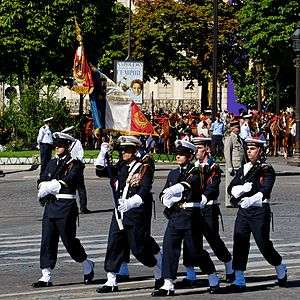
.jpg)
In military organizations, a colour guard (or color guard) is a detachment of soldiers assigned to the protection of regimental colours. This duty is so prestigious that the colour is generally carried by a young officer (Ensign), while experienced non-commissioned officers (colour sergeants) are assigned to the protection of the flag. These NCOs, accompanied sometimes by warrant officers (as is the case in several countries), can be ceremonially armed with either sabres or rifles to protect the colour. Colour guards are generally dismounted, but there are also mounted colour guard formations as well.
History
%2C_1910-12.jpg)
As armies became trained and adopted set formations, each regiment's ability to keep its formation was potentially critical to its, and therefore its army's, success. In the chaos of battle, not least due to the amount of dust and smoke on a battlefield, soldiers needed to be able to determine where their regiment was. Flags and banners have been used by many armies in battle to serve this purpose.
Regimental flags were generally awarded to a regiment by a head-of-State during a ceremony and colours may be inscribed with battle honours or other symbols representing former achievements. They were therefore treated with reverence as they represented the honour and traditions of the regiment. The loss of a unit's flag was not only shameful, but losing this central point of reference could make the unit break up. So regiments tended to adopt colour guards, a detachment of experienced or élite soldiers, to protect their colours. As a result, the capture of an enemy's standard was considered as a great feat of arms.
Due to the advent of modern weapons, and subsequent changes in tactics, colours are no longer used in battle, but continue to be carried by colour guards at events of formal character.
Current use
Britain and the Commonwealth
Colour guards in the United Kingdom and the Commonwealth are also composed of the same members as in the American units, but tend to have a colour sergeant major behind the colours carrying a pace stick. So, the formation (when the colours are combined on parade) is as follows:
- Colour Sergeants carrying rifles
- Ensigns
- Sergeant of the Guard
- Colour Sergeant Major behind the colour
As the British Army, the Royal Air Force, the Royal Marines and the Royal Navy have several types of colours, there are also colour guards for these colours and these colours and their colour guards are as follows:
British Army (line and guards infantry, and other units save for rifle units)

- Queen's Colour - Union Flag (Crimson with insignia and the honours for the Guards Division)
- Colour Sergeants and Ensign
- State Colour - Crimson with insignia and the honours and the Royal Cypher at the corners, used only for the Guards Division in ceremonies in the presence of the Queen and the Duke of Edinburgh
- Colour Sergeants and Ensign
- Regimental Colour - Union Flag on the canton with the Regimental Arms and honours
- Foot Guards regiments (Union Flag)
- Royal Regiments (navy blue)
- Royal Irish Regiment (green)
- other regimental colours
- same as in the Queen's Colour
- Combined Colour Guards (units)
- Colour Sergeants, Ensign, Guard Sergeant of the Colours, Colour Sergeant Major
British Army (Cavalry)
In the cavalry, the Queen's Standard or Guidon and the Regimental/Squadron Standard or Guidon (for the light cavalry only) are the equivalents to the Queen's and Regimental Colours.
- Queen's Standard - Crimson with the Royal coat of arms, the Royal Cypher and the regimental honours
- Colour Sergeant/Corporal of Horse, Warrant Officers
- Regimental/Squadron Standard/Guidon - Crimson or scarlet or other colours with the Royal Cypher, the Union Badge, regimental insignia and honours (only guidons are swallow tailed)
- same as in the Queen's Standard/Guidon
- Combined Colour Guards (units)
- Colour Corporals/Sergeants, Warrant Officers, Guard Corporal/Sergeant of the Colours, Colours Corporal Major (Household Cavalry), Colours Sergeant Major (other cavalry and armour units)
Colour guards in the artillery units are technically the lead gun's crew and leader (except in the Honourable Artillery Company which uses both guns and Colours) and there are no colour guards in the rifle regiments (nowadays The Rifles), the Royal Gurkha Rifles (which use the Queen's Truncheon) and in the Royal Hospital in Chelsea.
Royal Navy
All of the RN's Queen's Colours are identical.
- Queen's Colour - White Ensign defaced with the Sovereign's cypher and inscribed with honours
- Ensigns and Escorts
- White Ensign
- Same as Queen's Colour
- Combined Colour Guards
- Escorts, Ensigns, Guard Sergeant of the Colours, CSM
Royal Marines
- Queen's Colour - Union Jack with the Sovereign's cypher and the RM emblem and motto with the "Gibraltar" battle honour
- Ensigns and Escorts
- Regimental Colour - Union Jack on the canton and dark blue with HM King George IV's cypher and the unit name, and the Sovereign's cypher on the other corners
- Enisgns and Escorts
- Combined Colour Guards for the RM
- Escorts, Ensigns, Guard Sergeant of the Colours, CSM
Royal Air Force
- Queen's Colour - Royal Air Force Ensign with the Sovereign's cypher and the RAF roundel
- Ensign and Armed escorts
- RAF Ensign
- Same as Queen's Colour
- Squadron Colour - Air Force blue with the unit insignia and honours
- same as Queen's Colour
- Combined Colour Guards (units)
- Colour Sgts., Ensigns, Guard Sergeant of the Colours, CSM
Honours for and to the colour guard
Aside from presenting arms and sabres British and Commonwealth colour guards are expected to lower their flags to the ground in full and regular salutes in ceremonies and parades. Civilians should stand during such times and soldiers are expected to salute them when not in formation.
China
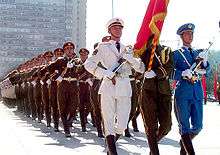
In the Chinese People's Liberation Army, colour guards composed of
- One ensign holding the flag of the People's Liberation Army as the national colour domestically or the flag of China abroad
- Two officers assisting the ensign holding rifles
France
French colour guards are composed of:
- One ensign holding the flag of France as the national colour
- Two non-commissioned officers assisting the ensign
- Three enlisted personnel behind to guard the colour
The colour guards of France's military academies tend to wear swords; those of NCO schools, other educational institutions and active units carry rifles instead.
Indonesia
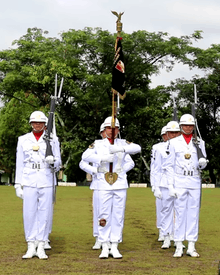
Pasukan Penjaga Panji-Panji/Pataka/Tunggul is the Indonesian term for a colour guard unit in the Indonesian National Armed Forces, the Indonesian National Police and the Municipal Police Units. These are modeled on the former Dutch practice and are led by a colour sergeant (massed colour guards are led on parade by a junior officer). Panji-Panji means "Service Colours" in Indonesian. The Colour guard uniform in Indonesia is all-white uniform with a white ceremonial combat helmet similar to the M1 helmet and white boots. If in the Armed Forces and the National Police, the escort personnel carry the M1, M-16, FN FAL or Pindad SSD-1 rifle while the colour officer carries his/her sabre.
Composition of the Indonesian colour guard unit
- Colour officer
- Lead squad carrying the unit colour or national flag
- One colour sergeant/ensign
- Two non-commissioned officers escorting the colour
- Relief squad
- One replacement colour sergeant/ensign
- Two non-commissioned officers
- Rear guard squad of three enlisted personnel (2 squads of 3-4 in the Indonesian Marine Corps)
Russia/CIS
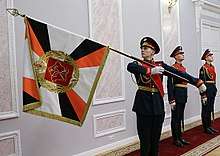
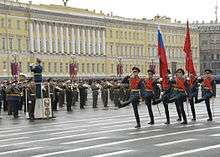

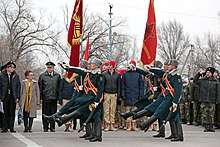
Russian colour guards are composed of:
- Colour officer
- One ensign or senior NCO holding the flag of Russia as the national colour or the unit color
- Two enlisted personnel assisting the ensign
Active units, military academies, and guards of honor carry sabers in the color guard, if needed, rifles may be substituted.
The same design is used for color guards in countries of the CIS.
Sweden
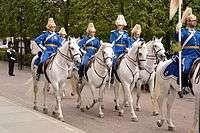
In Sweden the colour guard can be composed in three distinct manners: Greater colour guard, smaller colour guard and an officers guard. Each regiment, or military unit that carries a colour, in Sweden sets up its own colour guard. The Swedish military rank of fänrik (and the corresponding cavalry rank of kornet) was originally intended for the holder of the company flag. This duty was considered so prestigious that an officer was necessary to carry it out. Today, it is a regular officer rank.
Greater colour guard
This is composed of two commissioned officers, called fanförare (carriers of the colour) and eight enlisted soldiers. This stems from the time of king Gustavus Adolphus and the Thirty years war when all Swedish regiments had eight battalions. Each battalion contributed one soldier to the common colour guard.
Small colour guard
This is composed of one commissioned officer and four enlisted soldiers.
Officers guard
This is composed of three commissioned officers.
United States
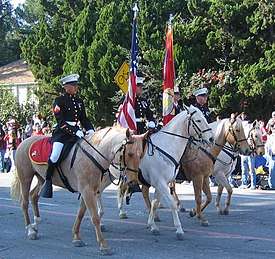
In the military of the United States, the color guard (where the word color is referring to the national flag) carries the National Color and other flags appropriate to its position in the chain of command. Typically these include a unit flag and a departmental flag (Army, Marines, Navy, Air Force, or Coast Guard). In addition to the flag bearers, who are positioned in the center of the color guard, there are two or more individuals who carry rifles and or sabres. This is a symbol that the flag (and its nation) will always be protected.
Composition of the US color guard
In the U.S., traditionally, the unit's sergeant major is responsible for the safeguarding, care, and display of the organizational colors. The sergeant major is also responsible for the selection, training, and performance of the members.[1] The color guard consists of enlisted members and is commanded by the senior (color) Sergeant, who carries the National Color and gives the necessary commands for movements and rendering honors during drill exercises or parade ceremonies.[2]
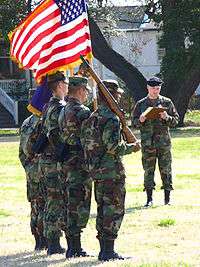
Being assigned to the color guard is considered an honor due to the fact that these individuals present and carry the symbols of their unit and country. Depending on the circumstance and subject to the orders of their commander, members may wear full dress or less formal uniforms. It is mandatory for all members of the color guard to wear headgear, for example, a garrison cap, beret, or service cap. On occasion, certain color guards can be horse-mounted.
A US color guard is made up of a "Color Sergeant" carrying the National Colors, a unit or command "Color Bearer", and two "Color Escorts".
Manoeuvering
The color guard is formed and marched in one rank at close interval (shoulder-to-shoulder). Since the National Colors must always be in the position of honor on the right,[3] the color guard must execute a special movement to reverse direction. It does not execute rear march, nor does it execute about face. Rather, it performs a maneuver derived from the standard countercolumn command, generally known as counter march or colors reverse march, in order to keep the precedence of flags in order.
Other drill movements performed by the color guard include presenting arms, left and right wheel (turns) marches, eyes right (upon passing the reviewing stand during a parade), casing/uncasing the colors, and fixing/unfixing bayonets (by the arms bearers).
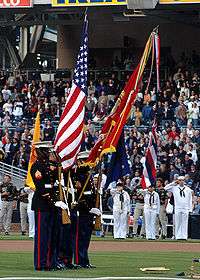
Rendering honors
By the color guard
The color guard renders honors when the national anthem is played or sung, when passing in review during a parade, or in certain other circumstances. In these cases, the unit and departmental flags salute by dipping (leaning the flag forward). However, with the exception of a response to a naval salute, the United States national flag renders no salute. This is enshrined in the United States Flag Code and U.S. law.
To the color guard
In the U.S. military, individuals or units passing or being passed by uncased (unfurled) colors render honors when outdoors. Individuals who are not part of any formation begin the salute when the colors are six paces distant and hold it until they have passed six paces beyond the colors.[4]
Civilians are expected to stand at the position of attention with their right hand placed over their heart for the same period, and the salute applies to the uniformed organizations as well (especially the Scouts). Since recently, veterans are expected to salute the colors too, like their military counterparts including personnel not in uniform.
Other countries
The Swedish military rank of fänrik (and the corresponding cavalry rank of kornet) was originally intended for the holder of the company flag. This duty was so prestigious that an officer was necessary to carry it out, but it required no officer training. Today, it is a regular officer rank. The Dutch armed forces have similar ranks of vaandrig and kornet (aspirant officers who have not been sworn in yet).
See also
References
- ↑ FM 22-5, Section 9, Paragraph 43 (e) Archived 2007-06-14 at the Wayback Machine. (United States Department of the Army)
- ↑ FM 22-5, Section 9, Paragraph 45 (a) Archived 2007-06-14 at the Wayback Machine. (United States Department of the Army)
- ↑ Morrow, JoyceE.; Schoomaker, Peter K. (July 2003). "FM 3-21.5 (FM 22-5) Drill and Ceremonies" (PDF). Center of Military History. United States Army. p. K-3. Retrieved 28 October 2014.
- ↑ FM 22-5, Section 9, Paragraph 43 (c) Archived 2007-06-14 at the Wayback Machine. (United States Department of the Army)
External links
| Wikimedia Commons has media related to Color guards. |